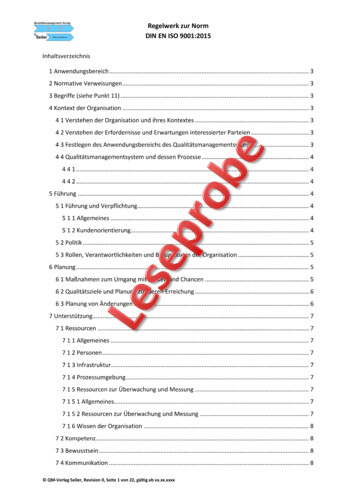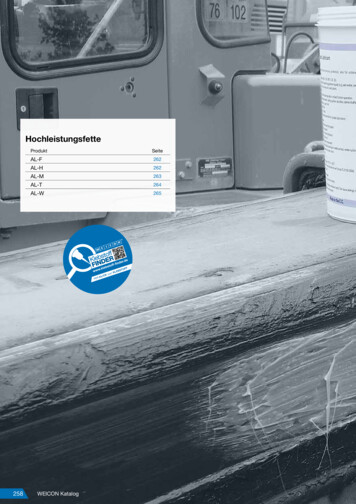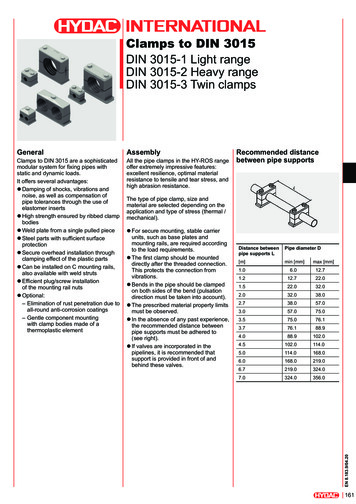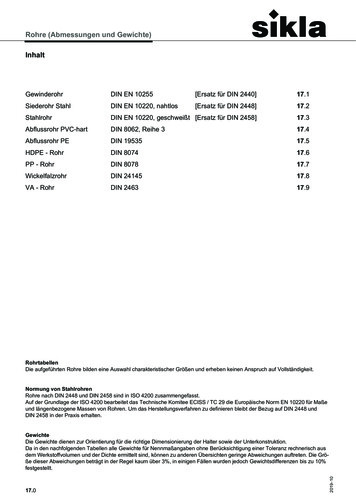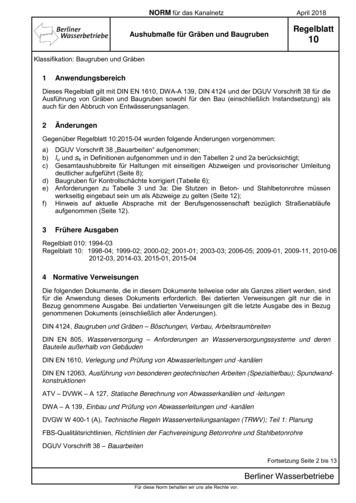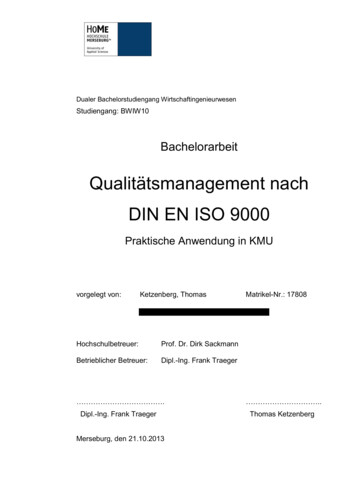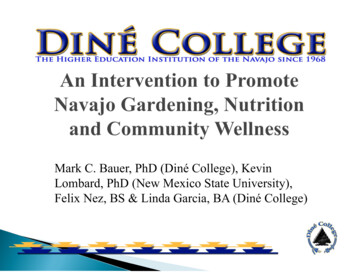
Transcription
Mark C. Bauer, PhD (Diné College), KevinLombard, PhD (New Mexico State University),Felix Nez, BS & Linda Garcia, BA (Diné College)
Goal: To improve communityhealth and wellness byencouraging family gardeningactivity and improvednutrition. Specific Aim 1: Evaluate whether the intervention (integrated technicalassistance, technical and behavioral workshops, and community outreach) isassociated with presence of a garden in the backyard and an increase infrequency of gardening.Specific Aim 2: Assess whether the association of the intervention(workshops and community outreach) is mediated by social norms aboutgardening, as well as self-efficacy and behavioral capability to garden.
Economic Considerations Navajo annual per capita income is 10,547, compared to 27,334 U.S.(U.S. Census 2010).Percentage of Navajo people belowthe poverty level is 37.7%,compared to 13.8% in the U.S.overall (U.S. Census 2010)Cost, availability, & shelf life offoods in remote areas affect dietarychoices.Obesity and Diabetes on theNavajo Nation Obesity is increasing amongthe Navajo 67% overweightor obese in NAIHS).Fruit and vegetableconsumption is low: over halfof adults 3 or fewer servingsdaily.2007: Type-2 diabetes is 14% of those 20-74 years ofage.
Stage of Change nce3025%Total120100%25Gardening Behavior45402015This question was based on theStages of Change model. Those inthe first three groups were thencategorized as “non-gardeners” andthe Action and Maintenance groupswere considered “gardeners.”1050
1412# Daily Servings of Fruits/VegetablesOf those respondents who reporteddaily fruit and vegetableconsumption (24 hour dietaryrecall): 35 gardeners reported meanservings of 5.5 (SD 3.7) 82 non-gardeners reported meanservings of 3.5 (SD 2.7) This is a significant difference:gardeners ate on average 2 moreservings of fruits and vegetables(TTest p .0035, with outliersremoved)1086420-2NonGardenersGardeners
Money Related IssuesIndividual imePhysicalAbilitySocialSupportNoneOther
Provide workshops that feature traditional gardening methods,use of indigenous seeds, as part of “master gardening”Encourage use of drip irrigation, water collection, dry farmingmethods in areas where irrigation infrastructure is non-existentor not functioningSeek partners (chapters, community groups, other programs towork on broader infrastructure issues: Water access – ditches, pumps, improved areas around othersources Assistance kits for new gardeners Equipment for loan
Family Gardens Fencing Soil Improvements Drip Irrigation Technical and Behavioral Workshops Site PreparationWhen/what to PlantIrrigationWeed/Pest ControlHarvesting & Seed SavingHealthy Cooking and Preserving
30 participating householdsfrom 4 Chapters(communities)Participants range from 21to 62 years of age23 Female; 7 Male18 live in establishedhousing areas; 12 rural26 of the 30 householdshad running water
Household gardens in Intervention. Components of these gardens includefencing to keep animals out, small wood gate, drip irrigation from NTUAtap water, and soil improvements.
1 Shovels, 1 Hoes, 1 Rake, Fencing materials: posts, clippings, metal fencing,and post driver, gloves, face mask, drip irrigation materials: 12-20ft, 9-2ft, 2-4fttubing, drip buttons: 10 per 20ft tubing, drip hole puncture: 1 or 2, 2 elbowconnectors, 9-10 T-shaped connectors, peat moss, organic compost, andvermiculite/pearlite
Key Explanatory Variables Knowledge: “Do you know how to ” Prepare a garden Maintain a garden Harest & store fruits and vegetables Self-Efficacy: “How confident, self-assured are you that you can ” Prepare a gardenMaintain a gardenHarvest and store fruits and vegetablesPrepare fruits and vegetablesEat fruits and vegetables every dayKey Outcome Variables Gardening Frequency (times/week) Servings of fruits/vegetables per day
Knowledge: “Do you know how to ”Prepare a gardenMaintain a gardenHarvest & store fruits and vegetablesSelf-efficacy: “How confident are you that you can Prepare a gardenMaintain a gardenHarvest & store fruits & 7104660.735.712202040.066.766.71620957.171.432.1
BaselineGardening frequency (times/week)Follow-upμ 95% CI3.3 0.0,6.1μ 95% CI7.6 5.5,9.52.9 2.3,3.63.1Paired t-test shows significantdifference between baseline andmidpoint (p .004)Fruit & Vegetable Servings (per day)Difference nonsignificant2.3,3.8
Final Data Collection QuestionnaireData Analysis to explore what knowledge, self-efficacy,and other intervention factors have impact on outcomesDissemination Efforts: Community dissemination to chaptersExtension materials for further disseminationTechnical report for area cooperative extension agentsPublication and presentation in a variety of Navajo Nation andadditional national conferences
USDA for the funding to Diné College’s Science Faculty and Land GrantOffice, and to New Mexico State University as a collaborator The Navajo Nation Human Research Review Board for approval of theresearch and input on the questionnaire NMSU IRB for research approval for the collaborating institution New Dawn for Donation of Seeds for Incentives Chapters (Shiprock, Hogback, Lukachukai, Tsaile/Wheatfields) for approvaland participation Student research assistants in the Diné College Summer ResearchEnhancement and NMSU Bridges Program
Lombard, PhD (New Mexico State University), . Seek partners (chapters, community groups, other programs to work on broader infrastructure issues: Water access -ditches, pumps, improved areas around other . NMSU IRB for research approval for the collaborating institution

